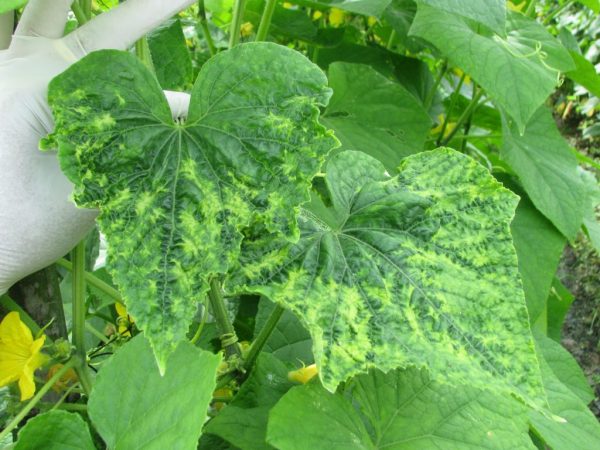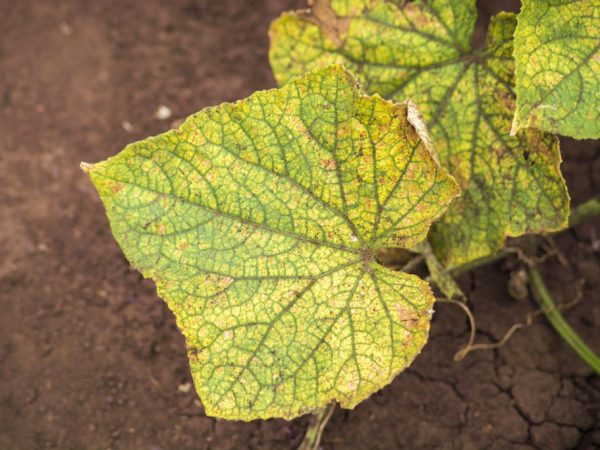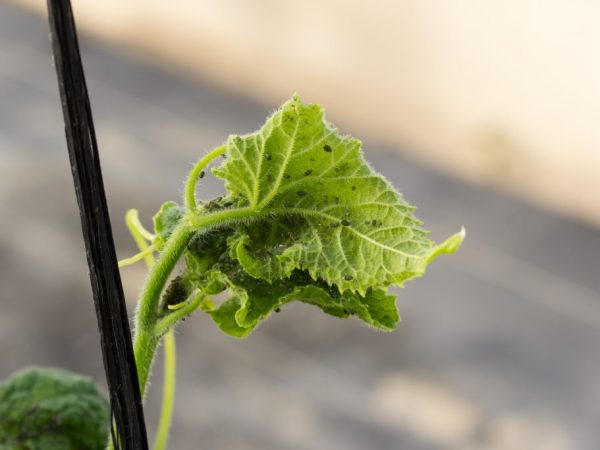Common pests of cucumbers and their control
Most often, crops such as tomatoes, potatoes and cucumbers are grown in vegetable gardens. Like all garden crops, cucumbers can sometimes be sore and damaged by parasites. Pre-planting seed treatment is a preventive measure, but if the plants are really sick, urgent treatment should be started. Consider what are the pests of cucumbers and what the plants are sick with.

Common pests of cucumbers and their control
Cucumber diseases
Diseases and pests of cucumbers are quite difficult to cope with. Many diseases are caused by:
- improper care;
- non-compliance with the rules of crop rotation;
- changing weather conditions.
When the first symptoms of the disease are detected, it is often necessary to immediately remove the damaged foliage or completely the entire bush in order to prevent infection. In addition, seed and soil pre-planting should not be neglected. One of the important preventive measures is the introduction of manure into the soil in the autumn.
Powdery mildew
The most common disease is powdery mildew. It affects not only cucumbers, but also many other garden crops, as well as flowers. It appears on the deciduous part, sometimes a white bloom is found on the fruits. It is initially a small white spot with a fluffy structure that expands over time and dries out the leaf.
As a result, the dried leaves begin to fall off. Untreated culture does not bear fruit well. Most often, the affected bushes die completely. The fungus progresses when constant temperature drops and high humidity are observed. Also, the disease develops rapidly when irrigated with cold water, in areas with strong ventilation.
The fungus spreads through:
- soil;
- weed grass;
- plantain;
- the roots of plants left over for the winter.
Treatment and prevention
Planting only the strongest varieties is a preventive measure. At the first symptoms of the disease, it is necessary to eliminate the affected parts of the tops and burn them. It is much easier to deal with powdery mildew in a greenhouse, you need to reduce the level of humidity, but in the open field, treatment with sulfur-containing substances is needed.
When the first symptoms of powdery mildew first appeared, potassium supplementation will perfectly cope with the situation. If the disease progresses, chemical treatment is necessary. Topaz, Oksikhom are often used.
Peronosporosis
This disease can very quickly destroy an entire field of cucumbers. The first symptoms of the disease are yellow-green spots covered with a light green bloom. The development of the disease begins with the upper leaves. The spots quickly spread to neighboring plants, forming a purple bloom on the inside of the leaves.

The disease is instantly transferred to neighboring plants
Most often, the disease occurs in June-July. Not one plant, but several plants at once affects. Downy mildew progresses in humid conditions with frequent temperature changes.The disease spreads very quickly, carried downwind.
Treatment
Disinfection of seed before planting with potassium permanganate. You should not allow high soil moisture and its strong cooling. A mandatory measure is regular feeding at all stages of the growing season.
If symptoms of the disease have already appeared, healthy seedlings should be treated with milk solution or urea. In severe cases, the use of chemicals for the treatment of peronosporosis is recommended. When a disease occurs, it is not recommended to plant cucumbers in this area for 5 years.
White rot
The disease quickly penetrates into the structural units of the plant, affecting all its parts. Cucumbers are covered with bloom. The disease often progresses in greenhouses with high humidity. In addition, the reasons for the development can be:
- too dense plantations;
- stagnation of air masses;
- temperature drops.
Treatment
First of all, it is necessary to restore the conditions that will contribute to the normal life of culture. Damaged branches and leaves must be removed immediately and destroyed. The remaining cuts should be powdered with wood ash to prevent contamination.
It is necessary to completely disinfect the soil, and in the greenhouse all the walls. It is important to remember that the pathogen can remain in the ground or on other objects for a very long time. Treatment with copper sulfate or urea solution is carried out.
Insect pests
Cucumber pests are quite diverse. The main method of protection against insects and diseases is proper care of your plantings, increasing the content of nutrients and air in the soil. All seeds must be disinfected before planting.
Before planting, you need to treat the soil with preventive disinfection solutions. Potassium permanganate solution is often used. The most common pests:
- aphid;
- spider mite;
- slug;
- bear;
- thrips.
Aphid

The plant may die from the invasion of aphids.
Most often, of all the insects that eat cucumbers, the melon aphid is found. To avoid being noticed, aphids usually hide from the inside of the leaves. When the leaves begin to actively fall off the plants, this is the first sign of the appearance of aphids. The yield is sharply reduced. Plants can die altogether if you do not intervene in time. The aphid has an oblong oval body, 2 mm long. Females have no wings, and the larvae can be with or without wings. Insects begin to breed in the spring, when the air warms up to 12 ℃. Females can produce up to 20 generations of aphids per season.
How to deal with a pest?
In the autumn period after harvesting, you need to completely remove the remaining tops and roots, process the soil with the correct technique and add organic matter. It is important to follow the rules of crop rotation. When aphids appear, it is necessary to treat the bushes with a solution of fermented grass or ash.
With a small number of parasites, it is recommended to treat the deciduous part with soapy water or just water pressure. You can fight parasites with the help of Iskra or Fitoverm preparations. After processing, you need to wrap the plants with foil.
Many people prefer to use natural insect control methods. For this, crops are planted that repel aphids:
- mint;
- mustard;
- coriander;
- garlic.
Spider mite
The spider mite is found both in the open field and in the greenhouse. It can live in any region and any climatic conditions. The insect clings to the inside of the leaf, sucks the juices out of it and wraps it up in a web. The end result is that the tops are completely dry. These insects are not easy to kill.
Fighting them requires a serious approach. It is recommended to spray seedlings with insecticides. Control methods also include the option of populating the territory with the natural enemy of the tick, phytoseiulus.It needs to be moved in every 2-3 weeks, it effectively destroys egg clutches. Will help get rid of the spider mite entomophthora adjarian fungus.
Slugs
Slugs can cause the development of diseases of the deciduous part of cucumbers. It is these parasites that carry the spores of the powdery mildew fungus and gray rot. Usually, slugs spread quickly in conditions of high humidity, in areas where there are many weeds, and also when there are many air voids in the ground.
To protect seedlings from damage by slugs, it is recommended to plant the crop in early spring. After harvesting, it is very important to remove all the tops and dig up the vegetable garden. The means of protection against slugs is to collect them by hand using tweezers. It is recommended to build grooves in the garden that will interfere with the normal movement of slugs.
Of the chemicals, metaldehyde and fluff lime are used. Spraying of seedlings is carried out several times at intervals of 2 weeks. Proper care and attraction of natural enemies of insects will guarantee their absence on the site in the future.
Medvedka
Bears are malicious pests on all cucumbers. These are relatively large insects, up to 5 cm in length, sometimes more. Both adults and larvae can cause harm. They eat the root system of plants, multiply quickly and in a short time are able to capture the entire territory.
It is recommended to process cucumbers outdoors with ready-made solutions, like Medvedko-s. After exposure to drugs, insects die within 3 hours. It is better to use this method right away, since in the fight against a bear, folk remedies are basically powerless.
Thrips
Thrips appear on leaves of cucumber seedlings. These pests are capable of producing up to 7 generations in a season. Both adults and small individuals are very dangerous for cucumbers. The first sign of a thrips attack is a change in the color of the greenery. As a result, the plants die.
After harvesting, it is necessary to disinfect the soil. Spray cucumber seedlings with drugs to prevent the appearance of insect pests. Processing of cucumber seedlings can be carried out using hot pepper infusion with soap. Spraying should be repeated at intervals of 5 days. Competent care will help to avoid the appearance of parasites and the development of many diseases.
Cucumber pests can ruin your harvest if not taken seriously.


